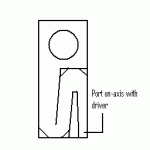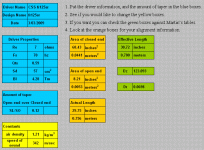I was wondering if it would be worth trying to build TL enclosures for my full ranges (when I get some)?
Could it be as simple as:
- Choosing a (1/4 wave) line length just below Fs;
- Designing a tapered, labyrinth line that fits inside the desired enclosure shape;
- Finding the cross sectional area;
- Having to adjust the line length for stuffing?
Would I be able to do this without going through such detail as I find on most of the websites I look at?
(Sorry, I don't really understand the math, just that the 1/4 wave, stuffing and tapered line helps reduce resonance and give lower bass output.)
Otherwise I may have to settle for a stuffed, deadened ported enclosure.
Could it be as simple as:
- Choosing a (1/4 wave) line length just below Fs;
- Designing a tapered, labyrinth line that fits inside the desired enclosure shape;
- Finding the cross sectional area;
- Having to adjust the line length for stuffing?
Would I be able to do this without going through such detail as I find on most of the websites I look at?
(Sorry, I don't really understand the math, just that the 1/4 wave, stuffing and tapered line helps reduce resonance and give lower bass output.)
Otherwise I may have to settle for a stuffed, deadened ported enclosure.
Simple answer is NO.
What you have described is classic TL design... http://t-linespeakers.org/design/classic.html
1/ you will get less bass if you tune a tapered or straight TL below Fs.
2/ a line that tapers such that the terminus cross-section is smaller than the start needs to be shortened
3/ damping has no effect on the length of the line (see 2)
You will be much further ahead just plugging a driver into Martin King's free alignment tables (available as a downloadable spreadsheet)
dave
What you have described is classic TL design... http://t-linespeakers.org/design/classic.html
1/ you will get less bass if you tune a tapered or straight TL below Fs.
2/ a line that tapers such that the terminus cross-section is smaller than the start needs to be shortened
3/ damping has no effect on the length of the line (see 2)
You will be much further ahead just plugging a driver into Martin King's free alignment tables (available as a downloadable spreadsheet)
dave
What FullRange drivers are you building an enclosure for? You may wanna see what someone here has figured out for them already. Some FR drivers will perform much better in a certain design and just ok in a simple sealed or OB. Some will not perform much better in a complicated design. Many fantastic enclosures have been designed here for Fostex FR drivers and it is a shame to put them in anything less.
If you haven't gotten your speakers yet, the best TL suggestion I can think of is the Alpha TL in the short article of a now dated issue of Speakerbuilder. Someone may know of a place which has it in another format. Measurements are given for the Jordan 92s.
What I was curious about is the mention of tables for Martin King's calculations that you could plug in values for that is downloadable at no cost. Can someone say more about that? I'm aware of Martin's page for subscribers but not the alignment tables.
What I was curious about is the mention of tables for Martin King's calculations that you could plug in values for that is downloadable at no cost. Can someone say more about that? I'm aware of Martin's page for subscribers but not the alignment tables.
Last edited:
Hi Lon, check out the alignment tables here: http://www.quarter-wave.com/TLs/TL_Theory.html
They are for classic TL's (straight, expanding, tapered) with one end open, as opposed to MLTL's (with the port).
They are for classic TL's (straight, expanding, tapered) with one end open, as opposed to MLTL's (with the port).
Ok. I get muddled with theory. Is this similar or the same as Rick's Alpha TL then?
That would seem ideal for this thread.
That would seem ideal for this thread.
I had a successful load of the TL spreadsheet in Open Office Spreadsheet. Compatibility with free software is a big plus.
What FullRange drivers are you building an enclosure for? You may wanna see what someone here has figured out for them already. Some FR drivers will perform much better in a certain design and just ok in a simple sealed or OB. Some will not perform much better in a complicated design. Many fantastic enclosures have been designed here for Fostex FR drivers and it is a shame to put them in anything less.
I was thinking of getting the Creative Sound Solutions fr125sr 4.5'' driver.
I'm a little attracted to the asthetics of the fr125sr more-so than the Fostex FX's (Sigma) at this stage, maybe it's because I like black better than white in speakers. The Fostex does seem to have better Qms and BL, though I'm just a little worried about the Xmax and the frequency response - it seems less flat than the CSS fr. I'll check out some of the designs to see what I think.
I put the values into the tables from Martin's site: (For the fr125)
Attachments
thanks for the reminder... I'll try to port my excel sheet to open office (anyone some tips on what to replace my VBA functions with in OO?)I had a successful load of the TL spreadsheet in Open Office Spreadsheet. Compatibility with free software is a big plus.
I was thinking of getting the Creative Sound Solutions fr125sr 4.5'' driver.
I'm a little attracted to the asthetics of the fr125sr more-so than the Fostex FX's (Sigma) at this stage, maybe it's because I like black better than white in speakers. The Fostex does seem to have better Qms and BL, though I'm just a little worried about the Xmax and the frequency response - it seems less flat than the CSS fr. I'll check out some of the designs to see what I think.
I put the values into the tables from Martin's site: (For the fr125)
you might want to also consider the CSS EL70 (by Mark Audio)
An externally hosted image should be here but it was not working when we last tested it.
http://www.creativesound.ca/pdf/CSS-EL70-data-080909.pdf
At $90 USD / pair, they are slightly lower cost than FR125, but don't have that sexy copper coloured phase plug.
I had a successful load of the TL spreadsheet in Open Office Spreadsheet. Compatibility with free software is a big plus.
How did you open it?
I just get strange fonts.
Hi Solve, does it open in your spreadsheet program, or display in the browser? If it displays in the browser, try this instead: right-click on the link and choose "Save Target as" or "Save Link As" and save to your hard drive, then open in your spreadsheet program.
thanks for the reminder... I'll try to port my excel sheet to open office (anyone some tips on what to replace my VBA functions with in OO?)
Hi Henkjan, OpenOffice uses a dialect of BASIC which is very similar to VBA. The syntax is the same, but the underlying objects are different, so you have to do a bit of renaming (and some recoding). Just for fun, try a snippet in this converter to quickly see some differences: http://www.business-spreadsheets.com/vba2oo.asp
Solve,
I hope you get your problem solved. For me it was just download the .xls file,
load, open and run the spreadsheet module and seek the file in XP. The color highlights and everything came up fine.
I hope you get your problem solved. For me it was just download the .xls file,
load, open and run the spreadsheet module and seek the file in XP. The color highlights and everything came up fine.
Martin King'sogram is the best I have ever seen and if you have a look at the frugel-horn.com web site, you will find a listing of some exceptional designs! It is a treasure trove for anyone seriously considering getting in to full range systems, IMO.
- Status
- Not open for further replies.
- Home
- Loudspeakers
- Full Range
- Simple document for building Transmission Lines?

